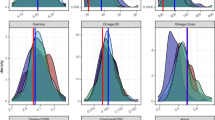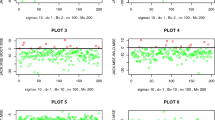Abstract
Finding an interval estimation procedure for the variance of a population that achieves a specified confidence level can be problematic. If the distribution of the population is known, then a distribution-dependent interval for the variance can be obtained by considering a power transformation of the sample variance. Simulation results suggest that this method produces intervals for the variance that maintain the nominal probability of coverage for a wide variety of distributions. If the underlying distribution is unknown, then the power itself must be estimated prior to forming the endpoints of the interval. The result is a distribution-free confidence interval estimator of the population variance. Simulation studies indicate that the power transformation method compares favorably to the logarithmic transformation method and the nonparametric bias-corrected and accelerated bootstrap method for moderately sized samples. However, two applications, one in forestry and the other in health sciences, demonstrate that no single method is best for all scenarios.



Similar content being viewed by others
References
Abu-Shawiesh MOA, Banik S, Golam Kibria BM (2011) A simulation study on some confidence intervals for the population standard deviation. SORT 35(2):83–102
An L, Ahmed SE (2008) Improving the performance of kurtosis estimator. Comput Stat Data Anal 52(5):2669–2681
Angelova JA (2012) On moments of sample mean and variance. Int J Pure Appl Math 79(1):67–85
Azzalini A (2014) The skew-normal and related families. Cambridge University Press, Cambridge
Banik S, Albatineh AN, Abu-Shawiesh MOA, Golam Kibria BM (2014) Estimating the population standard deviation with confidence interval: a simulation study under skewed and symmetric conditions. J Biomet Biostat 5:190. doi:10.4172/2155-6180.1000190
Barham AM, Jeyaratnam S (1999) Robust confidence intervals for the variance. J Stat Comput Simul 62(3):189–205
Bland M (2015) Estimating mean and standard deviation from the sample size, three quartiles, minimum, and maximum. Int J Stat Med Res 4(1):57–64
Bonett DG (2006) Approximate confidence interval for standard deviation of nonnormal distributions. Comput Stat Data Anal 50(3):775–782
Burch BD (2014) Estimating kurtosis and confidence intervals for the variance under nonnormality. J Stat Comput Simul 84(12):2710–2720
Butler RW, Paolella MS (2002) Saddlepoint approximation and bootstrap inference for the Satterthwaite class of ratios. J Am Stat Assoc 97(459):836–846
Ćojbašić V, Lonc.ar D (2011) One-sided confidence intervals for population variances of skewed distribu tions. J Stat Plan Inference 141(5):1667–1672
Ćojbašić V, Tomović A (2007) Nonparametric confidence intervals for population variance of one sample and the difference of variances of two samples. Comput Stat Data Anal 51(12):5562–5578
Cramér H (1946) Mathematical methods of statistics. Princeton University Press, Princeton
Davison AC, Hinkley DV (1997) Bootstrap methods and their application. Cambridge University Press, Cambridge
Efron B (1987) Better bootstrap confidence intervals. J Am Stat Assoc 82(397):171–185
Field CA, Ronchetti E (1990) Small sample asymptotics. Institute of Mathematical Statistics Monograph Series, Vol. 13. Institute of Mathematical Statistics, Hayward, CA
Herzel A (1963) Sui momenti centrali dei campioni estratti con o senza ripetizione. Biblioteca del METRON, serie C: Note e Commenti II:105–144
Herzel A (1982) On mean values and unbiased estimators in simple random sampling. Statistica 42:315–350
Herzel A (1987) Multivariate moments and products of moments, derivation of expectations and estimators from univariate formulae in simple random sampling. Statistica 47:3–27
Hummel R, Banga S, Hettmansperger TP (2005) Better confidence intervals for the variance in a random sample. Minitab technical report
Kittani H, Zghoul A (2010) A robust confidence interval for the population standard deviation. J Appl Stat Sci 18(2):281–290
Mudholkar GS, Trivedi MC (1981) A gaussian approximation to the distribution of the sample variance for nonnormal distributions. J Am Stat Assoc 76(374):479–485
Mukhopadhyay N (2000) Probability and statistical inference. Marcel Dekker Inc, New York
Rose C, Smith MD (2013) Mathematical statistics with Mathematica (eBook)
Rowlingson B, Diggle P (1993) Splancs: spatial point pattern analysis code in S-Plus. Comput Geosci 19(5):627–655
Terrell GR (2003) The Wilson–Hilferty transformation is locally saddlepoint. Biometrika 90(2):445–453
Tingley M, Field C (1990) Small-sample confidence intervals. J Am Stat Assoc 85(410):427–434
Wilson EP, Hilferty MM (1931) The distribution of chi-square. Proc Natl Acad Sci USA 17(12):684–688
Acknowledgements
The author thanks the Associate Editor and the two anonymous reviewers for their valuable comments and careful reading of this paper. The author also thanks Dr. A.J. Sánchez Meador in the School of Forestry at Northern Arizona University for providing the data in the forestry example.
Author information
Authors and Affiliations
Corresponding author
Appendix
Appendix
Rose and Smith (2013) developed computer software which can find unbiased estimators of products of central population moments. An unbiased estimator of, say, \(\mu _2 \mu _6\), is computed in terms of power sums, \(s_j = \sum _{i=1}^n X_i^j\). The power sums can be converted to functions of central sample moments and the coefficients of the central sample moments depend on the sample size (n).
Rights and permissions
About this article
Cite this article
Burch, B.D. Distribution-dependent and distribution-free confidence intervals for the variance. Stat Methods Appl 26, 629–648 (2017). https://doi.org/10.1007/s10260-017-0385-z
Accepted:
Published:
Issue Date:
DOI: https://doi.org/10.1007/s10260-017-0385-z




